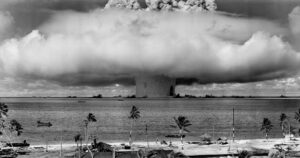If you’re one of those weirdos who likes the idea of hiking without cell service — Elon Musk would like to have a word.
The billionaire founder of SpaceX announced a new partnership with T-Mobile this week that will leverage the power of his Starlink satellites. Together, the two companies will offer a cell service plan that seeks to reach the most remote corners of the United States.
With a name seemingly inspired by “Toy Story,” Coverage Above and Beyond will provide “near complete coverage in most places in the U.S.,” according to a press release.
“The important thing about this is that it means there are no dead zones anywhere in the world for your cell phone,” Musk said. “We’re incredibly excited to do this with T-Mobile.”
Nearly 20 percent of the U.S. remains without access to cell signals. A combination of factors have made expanding into those areas difficult, including land-use restrictions in national parks, challenging terrain like mountains and deserts, and the sheer size of the North American continent.
While satellite phones have existed for a long time, they’ve remained expensive for the average consumer. Musk’s partnership with T-Mobile could result in total coverage of the U.S. for the price of a normal cell plan.
The companies said the service will initially only work in the U.S. — and likely no earlier than the end of next year, after new satellite launches from SpaceX, the press release said.
But there’s little doubt that in the long-term, Musk intends for this technology to reach the whole world.
How a Starlink and T-Mobile partnership could help
In the first two minutes of the promotional video, T-Mobile makes an undeniably compelling argument. The company pooled together a montage of athletes, workers, and parents giving soundbites about the dangers of a lack of communication.
We see sailors worried about weather, bush pilots concerned about rescues, bison ranchers who could die from injuries, and moms anxious about their kids.
The message is clear. Many people in rural areas suffer disproportionately from a lack of cell service.
Gaps in reliable internet and cell service persist between rural and urban America, the Pew Research Center reported last year. And the lack of infrastructure also hinders economic development, according to The American Conservative.
“Without adequate cellular coverage, [rural towns] remain invisible to the larger marketplace,” the article said.
About 19 million Americans still lack access to broadband service, according to the Federal Communications Commission. (It’s also worth pointing out that the FCC said several U.S. carriers, including T-Mobile, overstated their rural coverage as recently as 2019.)
For all these reasons, Musk said his new service could “save lives” by allowing cell phone communication in remote areas.
“If there aren’t too many people in the cell zone, you may potentially even have a little bit of video,” Musk said during a live press conference. “You might just have to wait half an hour, maybe, for the thing to go through, but it should still work…It’s not a substitute for ground cell stations, because ground cell stations, especially in urban and suburban areas, will definitely be superior to what we’re talking about here.
“This is really meant to provide basic coverage to areas that are currently completely dead,” he asserted.
Even Mount Kilimanjaro will soon get a cable car and cell service. So it shouldn’t be too surprising that it’s finally coming to rural America.






